Abstract
Epoxy resin systems have been associated with occupational asthma in several case reports, but medical publications contain little on the potential adverse respiratory effects of these chemicals in exposed worker populations. To further evaluate the association of workplace exposure to epoxy paints and respiratory dysfunction, the cross workshift changes in pulmonary function and symptoms of 32 shipyard painters exposed to epoxy paints were compared with 28 shipyard painters not exposed to epoxy paints. The prevalence of lower respiratory tract symptoms was significantly higher among painters exposed to epoxy paints compared with controls. Among exposed painters the mean cross workshift change in forced expiratory volume in one second (FEV1) (-3.4%) was greater than the decrement in the non-exposed group (-1.4%). A significant linear relation was seen between % decrement in FEV1 and hours of exposure to epoxy paints. This study suggests that epoxy resin coatings as used by shipyard painters are associated with increased lower respiratory tract symptoms and acute decrements in FEV1. Adequate respiratory protection and medical surveillance programmes should be established in workplaces where exposure to epoxy resin systems occurs.
Full text
PDF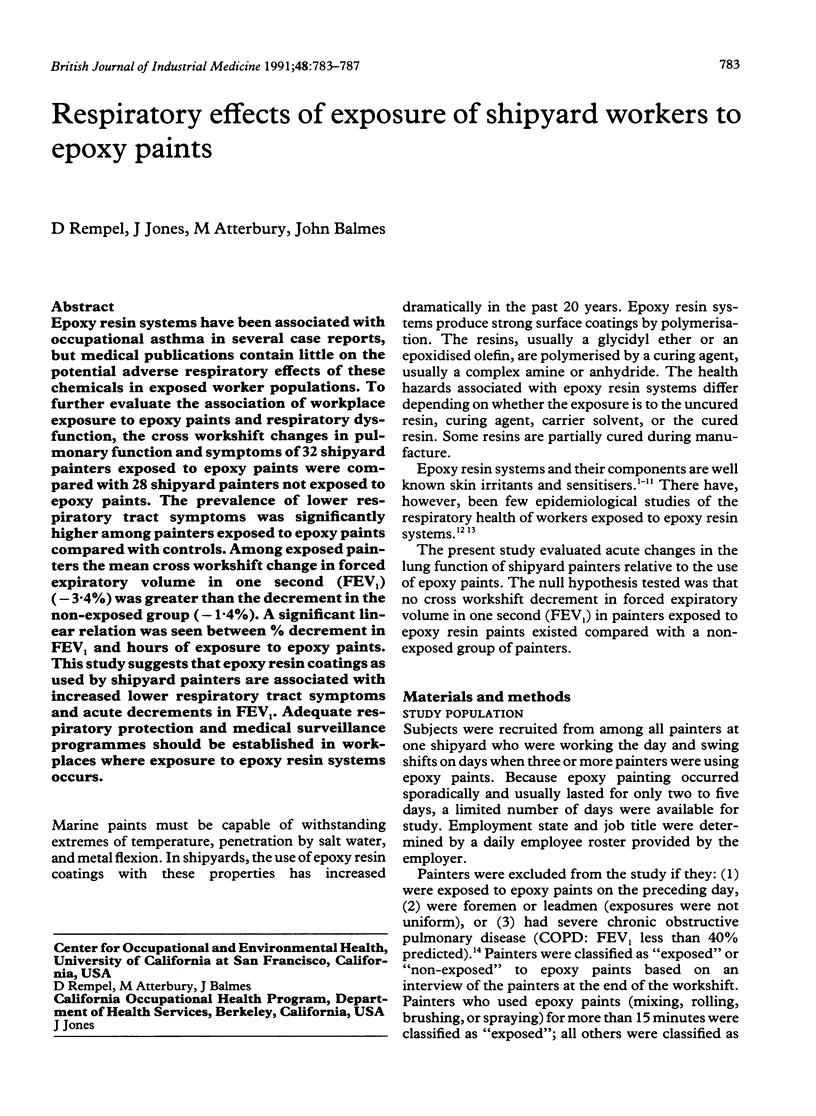
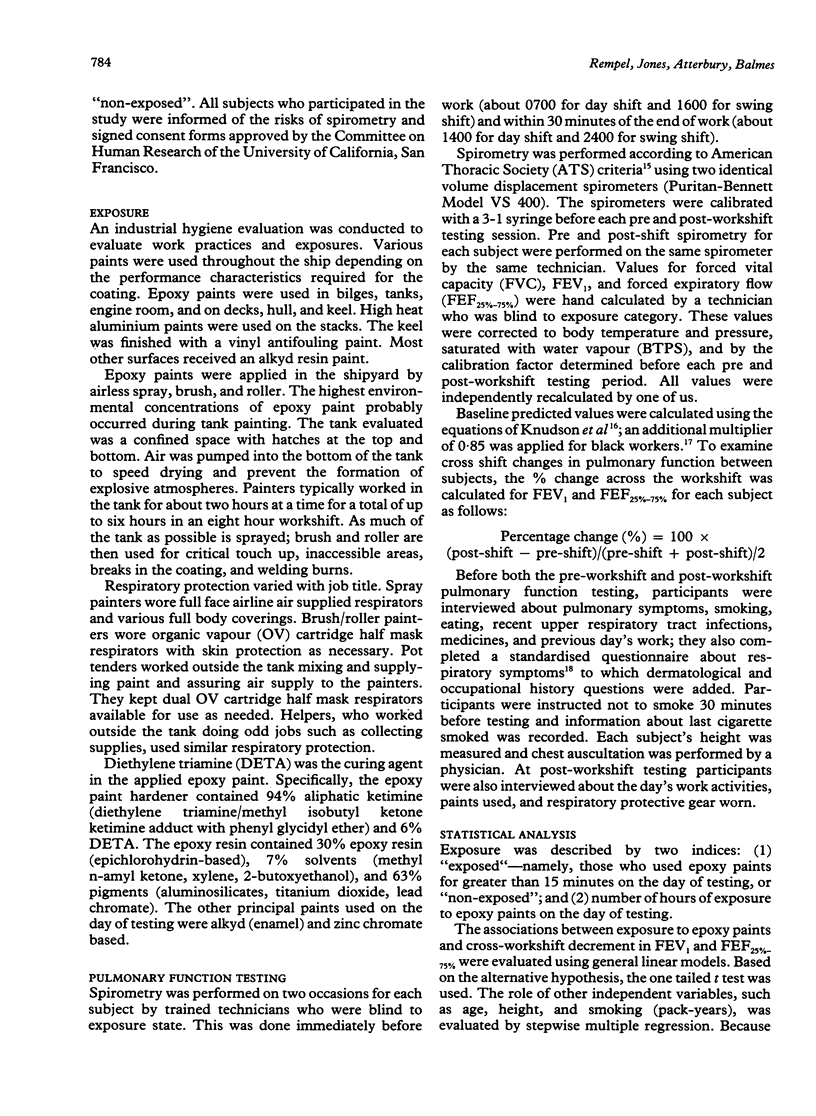
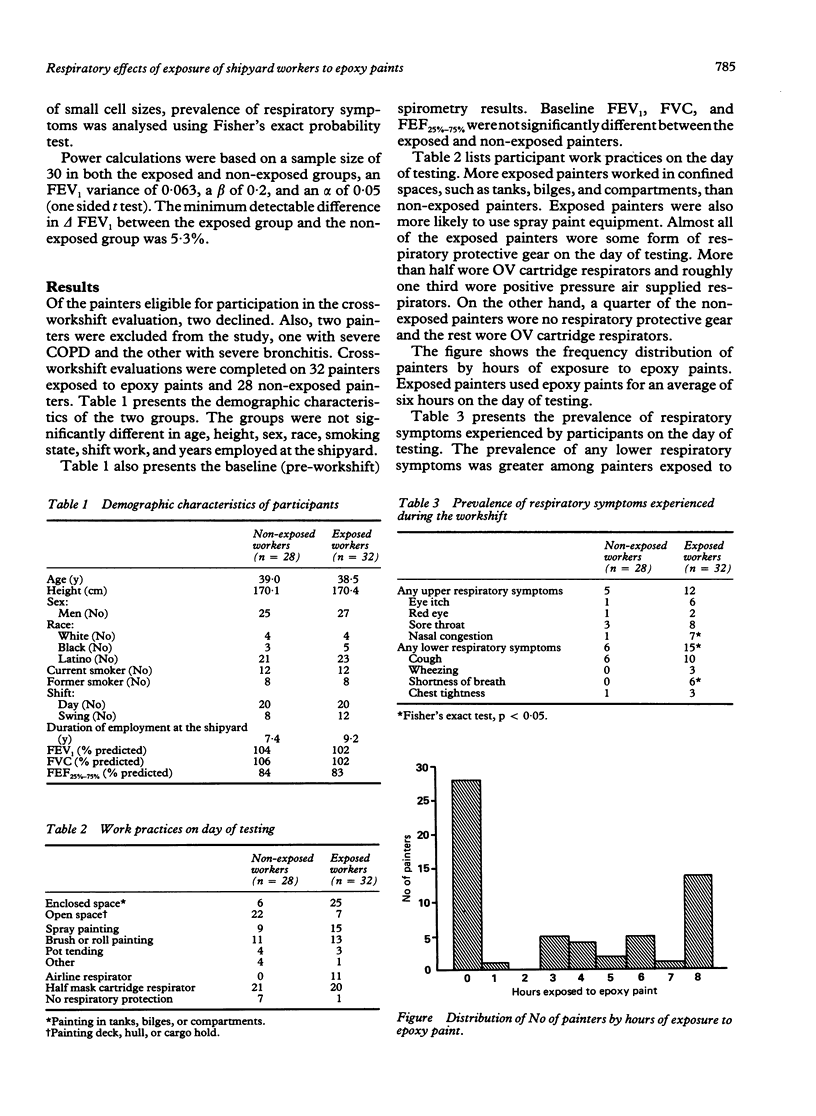
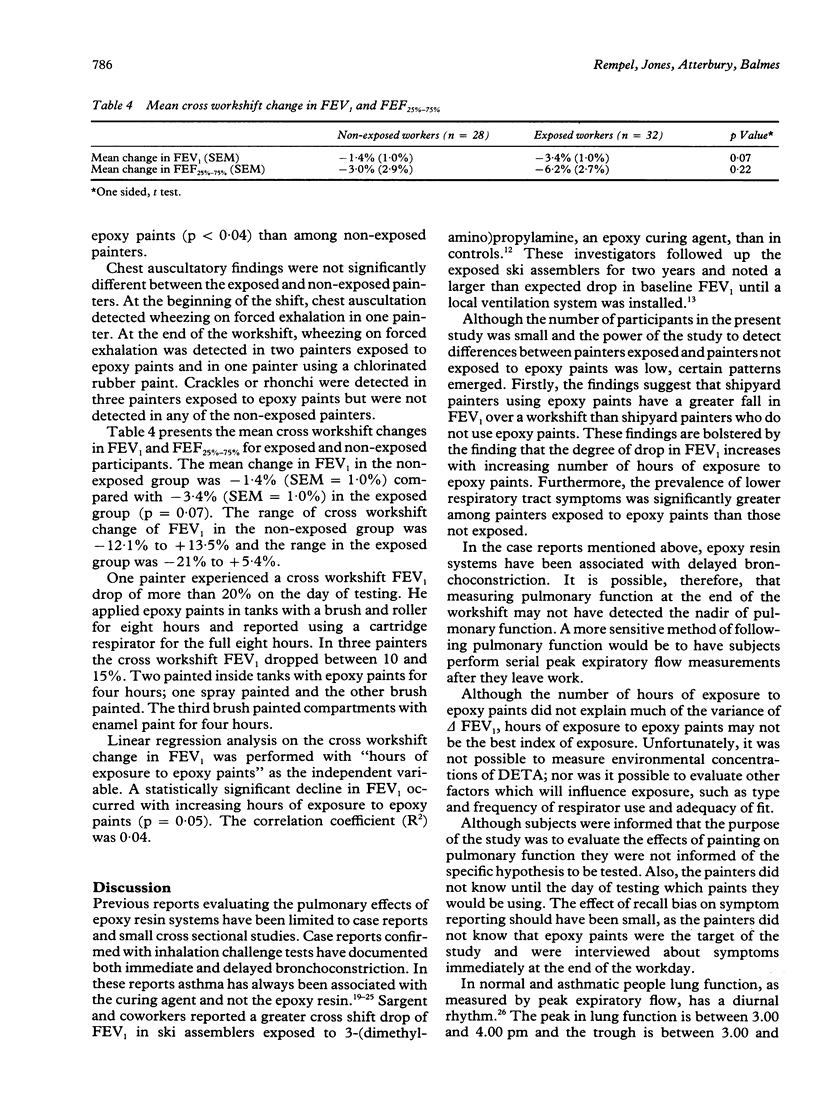
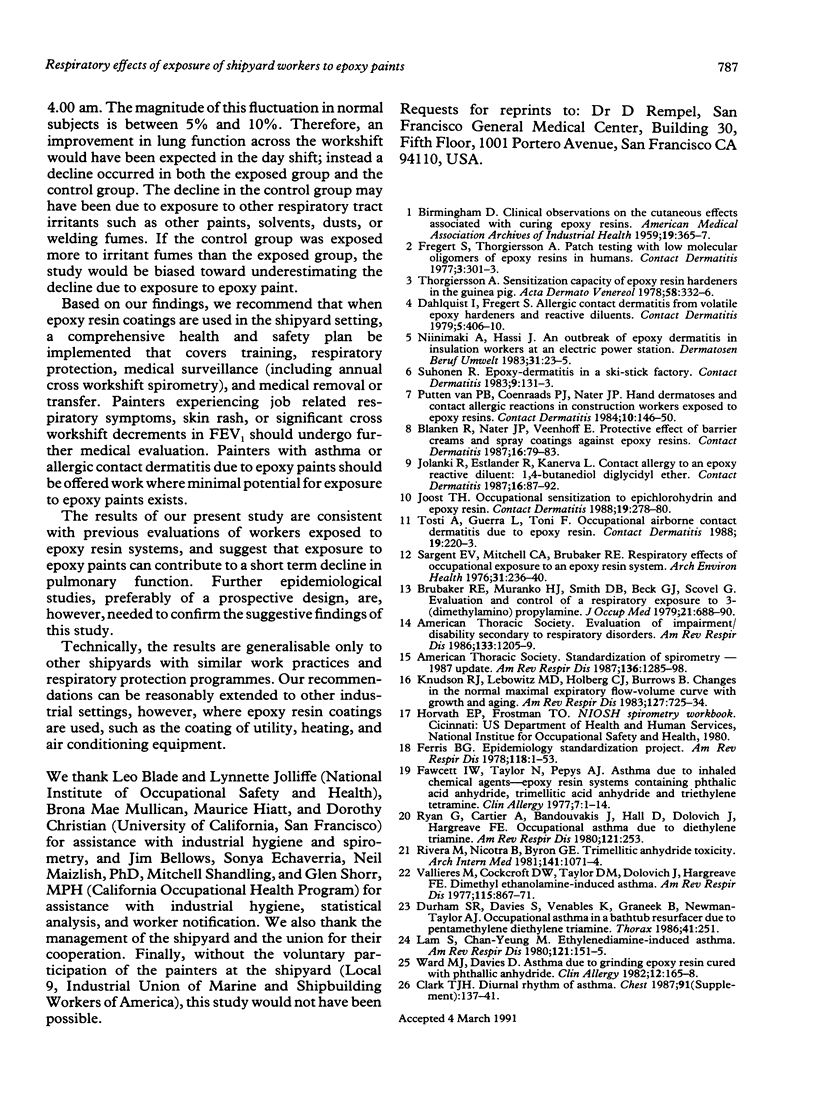
Selected References
These references are in PubMed. This may not be the complete list of references from this article.
- BIRMINGHAM D. J. Clinical observations on the cutaneous effects associated with curing epoxy resins. AMA Arch Ind Health. 1959 Mar;19(3):365–367. [PubMed] [Google Scholar]
- Blanken R., Nater J. P., Veenhoff E. Protective effect of barrier creams and spray coatings against epoxy resins. Contact Dermatitis. 1987 Feb;16(2):79–83. doi: 10.1111/j.1600-0536.1987.tb01383.x. [DOI] [PubMed] [Google Scholar]
- Brubaker R. E., Muranko H. J., Smith D. B., Beck G. J., Scovel G. Evaluation and control of a respiratory exposure to 3-(dimethylamino) propylamine. J Occup Med. 1979 Oct;21(10):688–690. [PubMed] [Google Scholar]
- Dahlquist I., Fregert S. Allergic contact dermatitis from volatile epoxy hardeners and reactive diluents. Contact Dermatitis. 1979 Dec;5(6):406–407. doi: 10.1111/j.1600-0536.1979.tb04920.x. [DOI] [PubMed] [Google Scholar]
- Fawcett I. W., Taylor A. J., Pepys J. Asthma due to inhaled chemical agents--epoxy resin systems containing phthalic acid anhydride, trimellitic acid anhydride and triethylene tetramine. Clin Allergy. 1977 Jan;7(1):1–14. doi: 10.1111/j.1365-2222.1977.tb01418.x. [DOI] [PubMed] [Google Scholar]
- Ferris B. G. Epidemiology Standardization Project (American Thoracic Society). Am Rev Respir Dis. 1978 Dec;118(6 Pt 2):1–120. [PubMed] [Google Scholar]
- Fregert S., Thorgeirsson A. Patch testing with low molecular oligomers of epoxy resins in humans. Contact Dermatitis. 1977 Dec;3(6):301–303. doi: 10.1111/j.1600-0536.1977.tb03691.x. [DOI] [PubMed] [Google Scholar]
- Jolanki R., Estlander T., Kanerva L. Contact allergy to an epoxy reactive diluent: 1,4-butanediol diglycidyl ether. Contact Dermatitis. 1987 Feb;16(2):87–92. doi: 10.1111/j.1600-0536.1987.tb01385.x. [DOI] [PubMed] [Google Scholar]
- Knudson R. J., Lebowitz M. D., Holberg C. J., Burrows B. Changes in the normal maximal expiratory flow-volume curve with growth and aging. Am Rev Respir Dis. 1983 Jun;127(6):725–734. doi: 10.1164/arrd.1983.127.6.725. [DOI] [PubMed] [Google Scholar]
- Kramps J. A., Bakker W., Dijkman J. H. A matched-pair study of the leukocyte elastase-like activity in normal persons and in emphysematous patients with and without alpha 1-antitrypsin deficiency. Am Rev Respir Dis. 1980 Feb;121(2):253–261. doi: 10.1164/arrd.1980.121.2.253. [DOI] [PubMed] [Google Scholar]
- Lam S., Chan-Yeung M. Ethylenediamine-induced asthma. Am Rev Respir Dis. 1980 Jan;121(1):151–155. doi: 10.1164/arrd.1980.121.1.151. [DOI] [PubMed] [Google Scholar]
- Niinimäki A., Hassi J. An outbreak of epoxy dermatitis in insulation workers at an electric power station. Derm Beruf Umwelt. 1983;31(1):23–25. [PubMed] [Google Scholar]
- Rivera M., Nicotra M. B., Byron G. E., Patterson R., Yawn D. H., Franco M., Zeiss C. R., Greenberg S. D. Trimellitic anhydride Toxicity. A cause of acute multisystem failure. Arch Intern Med. 1981 Jul;141(8):1071–1074. doi: 10.1001/archinte.141.8.1071. [DOI] [PubMed] [Google Scholar]
- Sargent E. V., Brubaker R. E., Mitchell C. A. Respiratory effects of occupational exposure to an epoxy resin system. Arch Environ Health. 1976 Sep-Oct;31(5):236–240. doi: 10.1080/00039896.1976.10667226. [DOI] [PubMed] [Google Scholar]
- Suhonen R. Epoxy-dermatitis in a ski-stick factory. Contact Dermatitis. 1983 Mar;9(2):131–133. doi: 10.1111/j.1600-0536.1983.tb04319.x. [DOI] [PubMed] [Google Scholar]
- Tosti A., Guerra L., Toni F. Occupational airborne contact dermatitis due to epoxy resin. Contact Dermatitis. 1988 Sep;19(3):220–222. doi: 10.1111/j.1600-0536.1988.tb02905.x. [DOI] [PubMed] [Google Scholar]
- Vallieres M., Cockcroft D. W., Taylor D. M., Dolovich J., Hargreave F. E. Dimethyl ethanolamine-induced asthma. Am Rev Respir Dis. 1977 May;115(5):867–871. doi: 10.1164/arrd.1977.115.5.867. [DOI] [PubMed] [Google Scholar]
- van Joost T. Occupational sensitization to epichlorohydrin and epoxy resin. Contact Dermatitis. 1988 Oct;19(4):278–280. doi: 10.1111/j.1600-0536.1988.tb02927.x. [DOI] [PubMed] [Google Scholar]
- van Putten P. B., Coenraads P. J., Nater J. P. Hand dermatoses and contact allergic reactions in construction workers exposed to epoxy resins. Contact Dermatitis. 1984 Mar;10(3):146–150. doi: 10.1111/j.1600-0536.1984.tb00020.x. [DOI] [PubMed] [Google Scholar]


